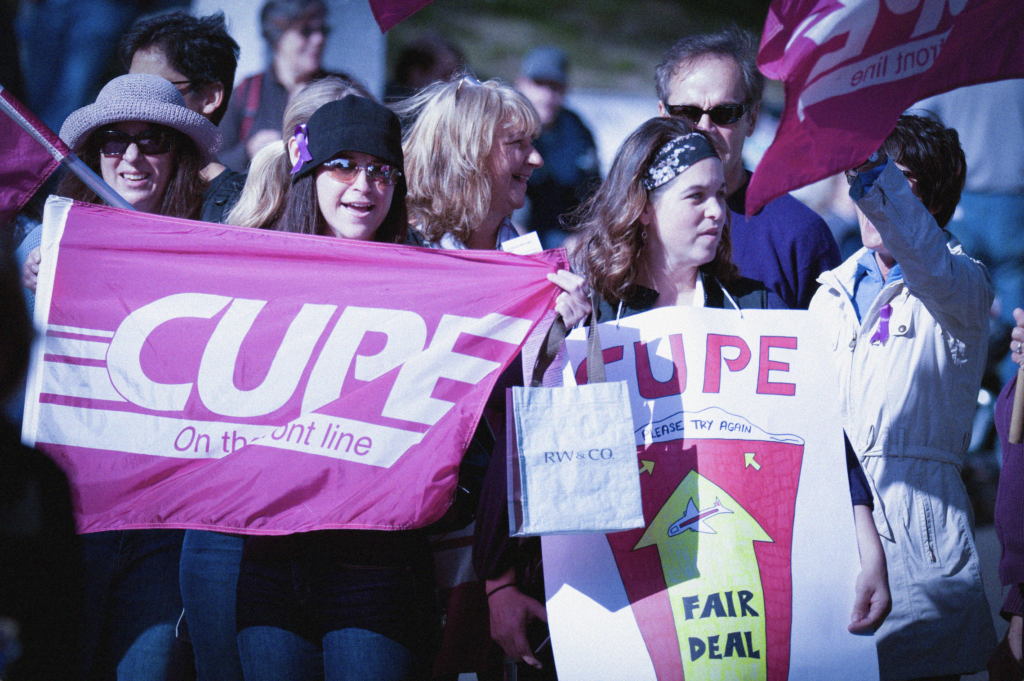Every activist I know was pleasantly surprised by the powerful response of the labour movement to the Ontario government’s nuclear attack on CUPE education workers—suspending the constitutionally-protected right to strike using the notwithstanding clause—not to mention the public response to it. Not since the Days of Action in the 1990s has the labour movement in Ontario stood up united to oppose government action. Not since then have we felt the power of organized labour to make change.
There has been much discussion as to why, and how, the fightback happened. I would like to argue that the increasing presence of feminist leadership is a major factor. The presidents of the Canadian Labour Congress (CLC), the Ontario Federation of Labour (OFL), the Ontario Public Service Employees Union (OPSEU), Unifor and the Toronto Labour Council are all feminist women. The President of CUPE Ontario is a gay feminist man. And of course the amazing leader of the CUPE education workers, Laura Walton, is a grassroots activist who provided the most sophisticated, effective, democratic and honest leadership I’ve ever seen in the labour movement—while dressed as Rosie the Riveter in the press conference where she announced the strike notice.
Feminism has played a special role in the Canadian labour movement. It’s no accident that the OFL organized an emergency demonstration the day after the U.S. Supreme court decision striking down Roe V Wade, which protected the right to abortion in the United States. At its 1982 convention, the OFL voted to support the then-illegal Morgentaler abortion clinic, a key factor in the later victory when Supreme Court struck down Canada’s law which heavily restricted abortion access. Labour supported feminist mobilizations and helped to defend the clinic against anti-choice violence. At that same convention they adopted affirmative action on their Executive Board for women.
In the chapter on union feminists in my book Ten Thousand Roses: The Making of a Feminist Revolution, Judy D’Arcy, a former National President of CUPE says that “the role of women in the Canadian labour movement is recognized all over the world. The union women organizing around affirmative action and choice were women who saw themselves as feminists. They saw themselves as active in the women’s movement.”
Organizers have always argued that there needs to be a critical mass to transform an organization.
Blocked from power by sexist men, union women organized both inside and outside the labour movement to gain more power and voice. With the expansion of the public sector throughout the 60’s and 70’s—jobs overwhelmingly worked by women—women became a larger part of the labour movement. In Ontario and Saskatchewan, feminists inside the labour movement set up organizations that included union and non-union women to organize for greater representation and support for feminist issues inside organized labour.
Ontario Working Women (OWW) organized feminists from outside the labour movement to walk the picket lines of female-dominated workplaces—especially in the garment industry—and trained union women to speak and work in a very patriarchal system. In Ontario there was split in OWW and some of the women focused on forming a women’s committee in the OFL—the same committee that later won the fight for affirmative action.
The late Deidre Gallagher tells the story in Ten Thousand Roses. “The fight to set up the OFL women’s committee was pretty heavy. We organized in all the different unions—AutoWorkers, Steel, and CUPE. Both Auto and Steel supported us and so did Cliff Pilkey, who was the OFL president at the time. We put forward a motion, but it was blocked on the floor. So the issue had to be decided by the executive, which had only one woman and she was anti-feminist. They had a huge showdown around it, but the motion finally passed by one vote with Pilkey as the deciding vote.”
There have always been female labour leaders, but they were usually isolated in a very patriarchal union structure. Grace Hartman and Madeleine Parent were union leaders who played a major role in the formation of the National Action Committee on the Status of Women, Canada’s largest and most influential women’s group during the rise of second wave feminism. Nancy Riche, Secretary-Treasurer of the CLC was also very active on feminist issues.
But organizers have always argued that there needs to be a critical mass to transform an organization.
Some people argue women are less likely to get into ego battles the way male trade union leaders often do. I have my doubts about that, but what is clear to me is that feminists have learned how to unite across difference when the issue is important, and to work together.
While we have achieved a critical mass of women in labour leadership, there is still a long way to go in terms of racialized people’s leadership. Of the prominent labour leaders at CUPE’s monumental press conference announcing victory over Ontario’s strikebreaking legislation, there were only a few people of colour.
June Veecock talks about being one of very few Black women at the 1986 OFL convention—where Julie Davis, a strong feminist, was the first woman elected as the executive vice-president of the OFL. “Women were feeling great about that, but I talked about how only white women were making gains.…There were incremental changes that we got through the Coalition of Black Trade Unionists.” In the labour movement today, there are a few racialized union leaders—but it’s important to increase their numbers to make the kind of difference we are seeing today for women.
It's been forty years since feminists in the labour movement turned their attention to building representation and strength in the labour movement. We are finally reaping the benefits.







